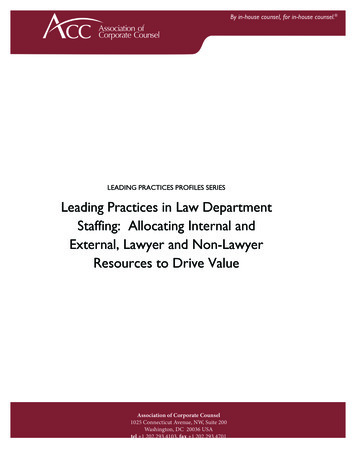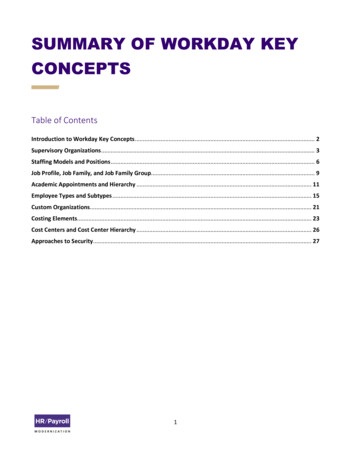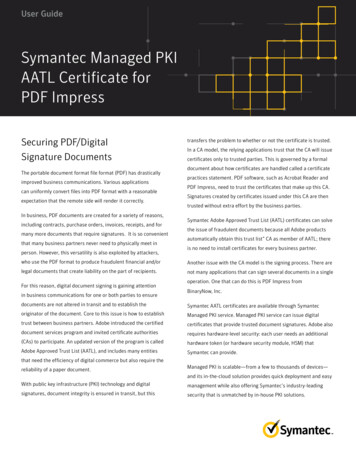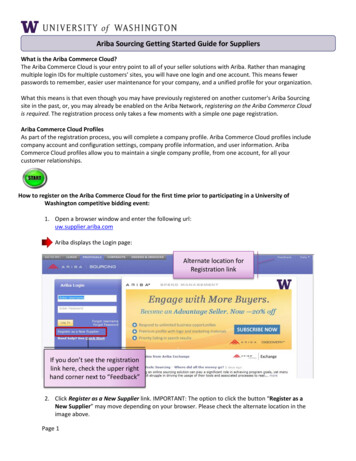
Transcription
!!!!!LEADING PRACTICES PROFILES SERIESLeading Practices in Law DepartmentStaffing: Allocating Internal andExternal, Lawyer and Non-LawyerResources to Drive ValueBecause the only thing faster
2Leading Practices in Law Department Staffing: Allocating Internal and External, Lawyer and Non-Lawyer Resources to Drive Value!!Because the only thing fasterthan your approaching deadlineshould be you.Practical guidance and sample forms to expediteevery transactional matter. Lexis Practice Advisor Draft documents for your transactional matters in record timewith Lexis Practice Advisor . You’ll find sample forms, draftingnotes and alternative clauses to help you streamline yourworkflow. Also, the practical guidance from leading attorneysgets straight to the point of what you need to know. See howmuch you can accomplish each day. Find out for yourselfwith a Lexis Practice Advisor 14-day trial.Choose Lexis Practice Advisor for your practice area.Banking & Finance Business & Commercial California Business & Commercial Corporate Counsel Financial Restructuring & BankruptcyIntellectual Property & Technology Labor & Employment Mergers & Acquisitions Real Estate Securities & Capital MarketsNo-cost, 14-day trial of Lexis Practice .628.3612*Lexis Practice Advisor Trial Offer is limited to individuals who are not current subscribers to Lexis Practice Advisor and who have been specially selected for this promotion.This offer is subject to your employer’s policies and is not available to any employees of any governmental entities. Use of the LexisNexis promotional ID is limited to theaddressee only and is subject to LexisNexis General Terms and Conditions located at www.lexisnexis.com/terms/general.aspx and the LexisNexis terms of use of thisparticular LexisNexis product. Promotional ID must be activated by June 30, 2015, to be eligible. Offer is valid for up to 14 consecutive days of use once Promotional ID isissued. This offer expires on June 30, 2015. Unused portions of this offer will not be credited or extended for future access. Your access can be terminated by LexisNexis at itsdiscretion. One Promotional ID per recipient. Promotional materials must be accessed by using the ID number received from LexisNexis. This offer may not be bundled withother offers. Other restrictions may apply.LexisNexis, Lexis Practice Advisor and the Knowledge Burst logo are registered trademarks of Reed Elsevier Properties Inc., used under license. 2014 LexisNexis. All rights reserved. PA00150-0 1014Copyright 2014 Association of Corporate Counsel!
Leading Practices in Law Department Staffing: Allocating Internal and External, Lawyer and Non-Lawyer Resources to Drive Value!3!!!!!!Leading Practices in Law Department Staffing:Allocating Internal and External, Lawyer andNon-Lawyer Resources to Drive Value!!!Updated September 2014!!!!!Provided by the Association of Corporate Counsel1025 Connecticut Avenue, NW, Suite 200Washington, DC 20036 USAtel 1 202.293.4103fax 1 202.293.4107www.acc.com!This Leading Practices Profile updates the 2004 ACC Leading Practices Profile, LeadingPractices in Using Non-Lawyer Personnel to Help Perform Legal Functions: WhatCompanies are Doing.The information in this Leading Practices Profile (“LPP”) should not be construed as legaladvice or legal opinion on specific facts, and should not be considered representative of theviews of ACC, unless so stated. Further, this LPP is not intended as a definitive statement onthe subject; rather, it is intended to serve as a tool for readers, providing practical,benchmarking information to the in-house practitioner.Lillian Moyano Yob, J.D., Legal Consultant for ACC, interviewed the featured participantsand wrote this Leading Practices Profile.For more information about ACC please visit our website at www.acc.com.Copyright 2009 Association of Corporate Counsel!!
!OverviewIn 2004, ACC published Leading Practices in Using Non-Lawyer Personnel to Help Perform LegalFunctions, to show how nine law departments had innovatively shifted work from lawyers toparalegals and new technologies for handling.A decade later, ACC revisits the topic with an updated Leading Practices Profile that asks lawdepartments in industries ranging from technology to health and telecommunications, to explainhow they’ve successfully allocated lawyer and non-lawyer resources to drive value.With mindful approaches that disaggregate and classify tasks, deploy a wider variety of lawyersand non-lawyers to perform them, and rely on technologies and external legal service providers toround out staffing of legal matters, the law departments of the following participating companiesshare their solutions for insuring the right resource is deployed at every stage of execution andthroughout the matter’s lifespan: A Multinational Computer Storage and Data Management Company BT Group plc 3M HeadLiveNation Bank of Montreal PrimeLending Cisco SystemsThe legal teams we profile offer their “best sourcing” approaches for achieving better legaloutcomes. To that end, this Leading Practices Profile showcases the best operational, technology,metrics and process improvement strategies for maximizing resources across the entire spectrumof legal operations.!
5!Contents!!I.Introduction . 6II.Law Department Staffing Themes and Leading Practices . 7III.A.Internal Initiatives: Strategic In-Sourcing, Centralizing Operations and Rotation of In-House Counsel . 8B.Looking Outside the Legal Department to Augment Performance: Centers of Excellence, ManagedService Providers, Shared Service Models and Outside Counsel . 9C.Leading Practices and Trends . 111.Leading Practices . 112.Trends . 12Company Program Summaries . 13A.Boosting Efficiency and Excellence Through Mapping and Knowledge Management:Cisco Systems Inc.’s Legal Global Center of Excellence . 14B.Reengineering How Legal is Done Through Managed Service Providers:A Technology Company’s Legal Operations Function . 16C.Building Internal Capabilities to Support Growth: 3M’s Strategic In-Sourcing Strategy. 19D.Innovating Performance and Reengineering Legal Spending: BT plc’s Shared Services Model. 23E.Aligning Legal with the Business Units:BMO Financial Group’s Centralization and Process Improvement Approaches . 26F.Meeting Operational Needs With a Small Legal Team:How PrimeLending Uses Resourcing Strategies to Prioritize Work . 31G.Focusing on Internal Staff and Technologies to Optimize Service Delivery:Live Nation’s Approach . 33IV.Additional Resources . 37V.Endnotes . 40!!For more Leading Practices Profiles please visit profiles/index.cfm!
6I.Leading Practices in Law Department Staffing: Allocating Internal and External, Lawyer and Non-Lawyer Resources to Drive Value!IntroductionTimes have changed since the options for handling a company’s legal work were limited tomanaging outside counsel and relying on that external counsel to execute the bulk of legal servicesfor the organization. Especially during the economic crisis that befell markets and businesses alikein 2008, the challenge for legal departments operating in the 21st century has been not only to domore, but to do more better, faster, with fewer staff and at a lower cost. With this reality as abackdrop, today’s award-winning law departments rely on carefully selected internal and externalstaffing to leverage all personnel resources.In 2004, ACC published Leading Practices in Using Non-Lawyer Personnel to Help Perform LegalFunctions to show how nine law departments had innovatively shifted work that had once beenperformed by lawyers to paralegals and new technologies for handling. A decade later, ACCrevisits the topic with an updated Leading Practices Profile that features law departments inindustries ranging from technology to health and telecommunications, to explain how they’vesuccessfully allocated lawyer and non-lawyer resources to drive value.Law departments profiled in this update demonstrate how legal operations officers, departmentand project managers, IT and human resources professionals, and external business units aresuccessfully performing functions that were once performed by lawyers. By carefully looking atthe universe of staffing options and considering what a wider variety of lawyers and non-lawyers,and internal and external providers can add to the value mix, these legal departments havetransformed the traditional staffing model to one that couples cost-effective legal services with thebest possible legal outcomes. To this end, companies share their best staffing models for enhancingvalue and drive client satisfaction.The legal leaders we interviewed explain how staffing strategies focused on internal personnel,technology assets and externally-based legal service providers are changing the way legal servicesare delivered. Their interviews reveal that corporate legal department efforts to manage demandthrough resource deployment are continuously improving, with strategies centered around thetwo major facets of staffing: internal initiatives and external partnerships.In-sourcing of tasks is becoming more common among a majority of legal departments. ACC’s2014 CLO Survey finds that as the CLO role becomes more strategic and influential, 63 percent ofrespondents are now regularly in-sourcing work formerly performed by outside legal serviceproviders. CLOs are being asked to analyze current business practices and make recommendationsthat will enable organizations to maximize efficiency and productivity. Additionally, the vastmajority (89 percent) of CLOs recognize the importance of professional development in advancingnon-legal skills among their staff. The non-legal skills most sought after include businessmanagement, project management, and communication – skills also identified by the legal leadersprofiled here as vitally important in rounding out the best-staffed legal departments.Copyright 2014 Association of Corporate Counsel!
7!Our legal leaders demonstrate how legal operationsofficers, department and project managers, IT and humanresources professionals, and external providers aresuccessfully performing functions once performed bylawyers. By carefully looking at the universe of staffingoptions and considering what a wider net of lawyers andnon-lawyers and internal and external providers can addto the value mix, these legal departments have transformedthe traditional staffing model to one that couples costeffective legal services delivered by the proper skill setwith the best possible legal outcomes. Large, medium andsmall legal departments with headquarters in the US,Canada and the United Kingdom share below their mostimportant considerations in staffing law departments toenhance value and drive client satisfaction.ACC ValueChallengeResourcesACC offers many usefulresources to help enhancethe value of legal services;many of these resourcesreside in the ACC ValueChallenge library. Withinthis library, ACC memberscan access tools andresources for value-basedstaffing in the dozens ofresources residing in theStaffing Options section.“Law departments and the [external partners] they retain need to maximize the use of alltheir resources – human, financial, and technological. The foundation for ensuring that allresources are leveraged to the fullest is making sure that the right work is being done bythe right people and that the processes they engage in to complete their work are the mostefficient and effective. That means sufficiently using the law department lawyers,paraprofessionals, and support personnel to focus on work that will have the greateststrategic impact on the company’s competitive position, and allocating other workelsewhere – sending it to outside counsel, outsourcing it to other vendors, or returning itto the business units outside the law department – or even eliminating it altogether. Itmeans examining work patterns and turnover times, providing necessary training, andimplementing metrics to drive greater value.”!- ACC Value Challenge Guide to Value-Based Staffing 2010II. Law Department Staffing Themes and LeadingPracticesThe seven organizations profiled here rely on staffing practices that range from internalevaluations to partnerships with external providers.For more Leading Practices Profiles please visit profiles/index.cfm!
8Leading Practices in Law Department Staffing: Allocating Internal and External, Lawyer and Non-Lawyer Resources to Drive Value!As a general rule, internal initiatives seek to match the right individual with her highest- and bestuse capability. External initiatives are focused on identifying legal service providers who arecapable of supporting the legal function seamlessly and cost efficiently, yet also able to becomeinvested in the relationship to function as a partner with specialized knowledge of the business.A.Internal Initiatives: Strategic In-Sourcing, Centralizing Operations andRotation of In-House CounselThe legal departments featured here have three principal strategies for driving value throughinternal staffing. These include: in-sourcing initiatives to meet specialized and mission criticalpractice areas; centralization of legal operations; and the rotation of in-house counsel to ensureattorney exposure in vital practice areas.The shift toward greater specialization of in-houseresources. Legal departments seek to refine the balancebetween needs and responses, productivity andefficiency. Staffing strategies at 3M, BMO and LiveNation are designed to reduce outside legal spend whilefreeing up resources to build capabilities in legal areasthat will support the company’s growth and addressemerging risk and compliance areas.With an approach that focuses on what the departmentdoes, rather than who it does it for, BT has restructuredits traditional legal services delivery model fromindividual legal teams assigned to specific business units,each with its own general counsel, to a core, centralizedteam that relies on a shared services model to managedemand and match tasks. Similar to 3M, the goal of theBT restructure was to find ways to free up internalresources in order to staff key growth markets. “Werealized we needed a more streamlined, more consistentway of operating in the UK if we were going to leveragelegal resources to growth areas and offer better service ina more competitive environment,” explains Chris Fowler,GC for the UK Commercial Legal Services Division.BT’s ValueJourneyBT restructured the legaldepartmentbyreexamining its internaland external resources,regionalizing work andreviewing its knowledgemanagement tools andperformance managementapproaches. To learn moreabout BT’s reengineeredstrategy, see The ValueJourney: Innovating andReengineeringLegalSpend, presented at theACC2013AnnualMeeting.A number of legal departments are centralizingfunctions to achieve greater alignment with businessand operational units. BMO’s legal group became a centralized corporate function in 2008. As partof the restructuring, the team consolidated three functions to become the Legal, Corporate andCompliance Group. Restructuring allowed LCCG to align with each of BMO’s main lines ofbusiness, in the process affording each line its own Deputy General Counsel as legal leader.Although aligned with specific business units, however, the legal function is independent of thebusinesses. “By operating as core central legal groups,” Deputy GC and Chief AdministrativeOfficer Sonnen explains, “the General Counsel has been able to leverage efficiencies and create areally strong legal department that has a brand of its own, that has a talent development plan of itsCopyright 2014 Association of Corporate Counsel!
9!own, and that serves almost as a law firm within the bank but that is nevertheless heavily based ona relationship model.”Centralization at PrimeLending’s small legal department facilitates the team’s ability to analyzeworkload to grow and contract as needed. This adaptive structure allows the group to maximizeits impact by remaining cohesive and agile. At BT, a very small central function with substantivecomponents embedded in the lines of business led attorneys to focus inordinately on who theyprovided services for, rather than what they were offering. The solution was to reorganize thisdecentralized model into a shared services model that refocuses BT legal on the what over the who.When data revealed that there was room to improve how task complexity and risk were matchedwith cost, “we took a view that we needed to reevaluate how we did things and get a lot better atdemand management and reexamining roles and responsibilities.” The result of restructuring forthese legal teams has been a freeing up of attorney resources to execute high level, high-risk workand balancing strategic priorities with effective execution.To keep counsel motivated and meet emerging strategic priorities with seasoned staff, lawdepartments like BMO’s expose in-house counsel to all areas of operations by rotating themregularly within the lines of business. Beyond the versatility it creates, rotating counsel acrosslegal operations helps limit attrition. “Because our people feel challenged and know they will beexposed to all areas if they are strong, we keep exceptionally dedicated and talented resourceswithin the organization,” explains Sonnen.B.Looking Outside the Legal Department to Augment Performance:Centers of Excellence, Managed Service Providers, Shared ServiceModels and Outside CounselIn addition to their focused initiatives for leveraging resources internally, the law departmentsfeatured here have implemented partnerships with external providers to enhance their valueoutput. These partnerships have been forged with centers of excellence, managed serviceproviders, shared service models and external counsel. The results of these externally-focusedefforts have been impressive for the featured organizations: law departments report significantlyenhanced productivity thanks to streamlined, around the clock, “all under one roof” solutions thatoffer seamless support while reducing spend both absolutely and as a percentage of revenue.Customized technology systems that allow evaluation and tracking of vital, cost-saving data arealso part of the optimization strategy.Global Centers of Excellence provide global staffing and around the clock in support of anyspace involving repeatable and established legal matters. Once an emerging business and itslegal model matures, the center can take over and support cost-effectively by identifying patternsand deviations, standardizing processes and tailoring tasks. “So long as the matter is repeatable,we can manage complexity,” explains Tanya Vasilev, Legal Director and architect of Cisco’s GlobalCenter of Excellence (gCOE). The level of productivity achieved by the leanly staffed Cisco gCOEhas been remarkable: over the past four quarters since 2013, output has increased by anoverwhelming 103%. At the same time, customer satisfaction hovers consistently at 4.98 on a scaleof 5.0. Savings have also been impressive: compared to the last quarter of the prior year, averagecost per transaction was down by 39%.For more Leading Practices Profiles please visit profiles/index.cfm!
10Leading Practices in Law Department Staffing: Allocating Internal and External, Lawyer and Non-Lawyer Resources to Drive Value!The legal strategy of the computer storage and data management company for right sourcing tasksand managing workflows across different organizations includes the creation of a legal operationsfunction that disaggregates matters and works with external providers. The latter component relieson a managed services strategy that can 1) provide resources to serve as an extension of theinternal legal team, and 2) enable the matching of right resources to the right work across a broadrange of legal, technical and analytical functions. According to this department, managed serviceprovider structures offer a more holistic level of support than traditional LPOs, which tend tobe more project based. This company has found that a managed service provider can assist withdocument reviews, provide attorney support for a complex M&A, and offer vendor management,analytics, and support for commoditized work. “It’s all under one roof. They are capable ofoperating as a true extension of our legal team,” explains the Director of Legal Operations.Shared services models like the one adopted by British Telecommunications allow legal teamsto restructure traditional legal service delivery models from ones composed of individual legalteams assigned to specific business units, into core, centralized teams that focus more on whatthey do than who they do it for. The resulting matrix organization is a leading practice fordepartments like BT’s. Shifting to this centralized approach required BT to focus on a staffingmodel that could optimize legal value through streamlined “best sourcing” initiatives capable oftracking needs and delivering the right blend and cost of off-shore, in-house, multi-shore andexternal resources appropriate for the task. When surveys and data revealed the lack of goodmatching of task complexity with risk/ cost/location, BT legal introduced of a front door, webbased log system that allowed its LPO to triage requests instantly. Measureable success soonfollowed: within three years, 30% of workload requests were being outsourced to the LPO at a costof 1/14th that of the UK-based lawyers. And as with the other models, the resulting shift of lesscomplex/high volume, commoditized matters to the outsourced legal provider freed the internaldepartment to take over the more complex, high-value work, as realized new savings wereinvested into expansion into growing geographies and functional areas.The focus on external counselmanagement is a leading practicefor law departments seeking waysto ensure alignment with corporatevalues and strategic priorities and ahigh-value return on outsidecounsel investment. By convergingcomplex matters into a preferredpool of outside firms, legaldepartments at 3M and BT are ableto reduce outside counsel legalspending while freeing up resourcesto invest in building capabilities tosupport the company’s growth andemerging risk and compliance areas.For an in-depth look at leadingconvergence practices – frominitiation through selection anddownrange management of theoutside counsel preferred providerThe goal of convergence, beyond that of reducingoutside counsel spend, is to identify a key number offirms with whom we have mutual trust-basedrelationships, and in the process make ourselvesmore relevant to the firms we work with andimprove the communication and depth ofunderstanding that our firms have with us and us ofthem.– 3MThe goal is to use external counsel in high-risk areaswhere we’re going to get a high-value return.– BMO Financial GroupCopyright 2014 Association of Corporate Counsel!
11!network – look for ACC’s next Leading Practices Profile, Converging Law Firms: Leading Practices forSelecting, Implementing and Managing a Value-Driven Preferred Network, coming soon and to bepublished here.Regular evaluation of outside firms through quarterlyACC offers Legal Servicebusiness reviews and performance evaluations is oneManagement Workshopsnoteworthy way leading departments track resourcesdesigned to provideand provide meaningful feedback. Live Nation’s practicehands-on training in keyof requiring regular reporting from its external counselhas helped its legal group achieve greater value frommanagement techniques.Attendees learn how totheir law firms “by making sure the right attorneys areimprove control andassigned to a matter and working efficiently, settingefficiency and facilitate thecorrect expectations, and guiding internal and externalcounsel to work within those expectations so that we canimplementation of valuebased fees. The workshopsbudget more accurately.” Quarterly and annual businessare also a goodreviews of outside firms by Net App and BMO allowopportunity to networkexternal counsel to understand what is being measuredwith others committed toand why. Through these regular communications, “wedriving value. Looking fortell our external counsel how [and why] they werea more customizedchosen,” explains Anne Sonnen, BMO Deputy Generalexperience? ACC alsoCounsel and Chief Administrative Officer. “[W]e conveyoffers private workshopsthat we expect them to understand our values, whichin your own legalinclude firm diversity and innovation both in the use ofdepartment. Learn morealternative fee arrangements and innovative staffingmodels that help us manage costs more effectively. Wehere.]emphasize our expectation that they deliver services thatare consistent with these values. And through ongoingconversations, the execution of a mini ACC ValueChallenge workshop with external counsel, we have opened dialogue and encouragedconversations about how to move away from the billable hour.”C.Leading Practices and Trends1.Leading PracticesBeyond the Leading Practices addressed above, the following additional strategies are identified asleading practices:Developing Critical Capabilities to Leverage Providers. The ability to leverage the skills ofmultiservice providers and manage that relationship is a leading practice for the computer storageand data management company and other legal departments. Developing critical capabilities thatmake resource shifting a seamless process enables the company’s legal department to integrateservices and operate a successful legal ecosystem capable of tapping support from various sources24/7.!For more Leading Practices Profiles please visit profiles/index.cfm!
12Leading Practices in Law Department Staffing: Allocating Internal and External, Lawyer and Non-Lawyer Resources to Drive Value!Enhanced Technologies as Part of the Value Mix. Improvements in technology and the ability tocustomize platforms for specific needs is a leading practice for legal departments. Integratingtechnology into legal operations facilitates task in-sourcing and the triaging of unbundled,routine work. At Live Nation, a fully customized internal discovery platform managed by atrained paralegal eliminated the department’s exclusive reliance on external staff and contractattorneys for e-discovery/technology/electronic document processing. The platform was a smartand cost-effective leading strategy at Live Nation. LPO 2.0 solutions also allow departments likeBT’s to shift commoditized work over to technology systems, in the process freeing up internalcounsel to provide more advisory (and fewer process) services is another technology-drivenleading practice. BMO’s Sonnen agrees: “Even though there’s been an increase in demand forservices, we have been able to reallocate resources to cover it because [SharePoint and e-filingtechnology systems] allow us to work smarter and better in our process.”2.TrendsWithin the themes identified above, several trending areas in law department staffing areidentified. Notable ones include:In-Sourcing Specialized Roles and e-Discovery. In-sourcing functions is an area of growingprominence for law departments seeking to maintain budget discipline. 3M has successfullyinternalized its transactional, environmental, employment, and credit and collection functions torealize its goal of reinvesting realized savings to strengthen legal resources for these strategicallyimportant practice areas. At LiveNation over the past five years, enhanced technologies (includingSymantec’s Clearwell eDiscovery Platform) and paralegal training have enabled the legaldepartment to manage more of its electronic discovery needs in-house. As a result, the departmenthas decreased its reliance on external staffing for e-Discovery review and document processing. AtPrimeLending, the in-sourcing of electronic discovery/processing has saved this small legaldepartment over 2 million in exporting and processing fees over the last two years.Process and Project Management. Another trend is the leveraging of process and projectmanagers to achieve highest use, most efficient allocation of internal and externa
Overview In 2004, ACC published Leading Practices in Using Non-Lawyer Personnel to Help Perform Legal Functions, to show how nine law departments had innovatively shifted work from lawyers to paralegals and new technologies for handling. A decade later, ACC revisits the topic with an updated Leading Practices Profile that asks law










